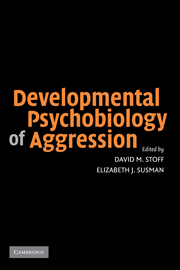Book contents
- Frontmatter
- Contents
- Foreword
- INTRODUCTION
- PART I PLASTICITY
- PART II BIDIRECTIONALITY
- 6 Touch Deprivation and Aggression Against Self Among Adolescents
- 7 Intersections of Biology and Behavior in Young Children's Antisocial Patterns: The Role of Development, Gender and Socialization
- 8 Life-Course Persistent and Adolescence-Limited Antisocial Males: Longitudinal Followup to Adulthood
- 9 A Biocultural Life History Approach to the Developmental Psychobiology of Male Aggression
- PART III GENE–ENVIRONMENT INTERACTIONS
- CONCLUSION
- Author Index
- Subject Index
- References
9 - A Biocultural Life History Approach to the Developmental Psychobiology of Male Aggression
Published online by Cambridge University Press: 14 July 2009
- Frontmatter
- Contents
- Foreword
- INTRODUCTION
- PART I PLASTICITY
- PART II BIDIRECTIONALITY
- 6 Touch Deprivation and Aggression Against Self Among Adolescents
- 7 Intersections of Biology and Behavior in Young Children's Antisocial Patterns: The Role of Development, Gender and Socialization
- 8 Life-Course Persistent and Adolescence-Limited Antisocial Males: Longitudinal Followup to Adulthood
- 9 A Biocultural Life History Approach to the Developmental Psychobiology of Male Aggression
- PART III GENE–ENVIRONMENT INTERACTIONS
- CONCLUSION
- Author Index
- Subject Index
- References
Summary
New Guinea, early 1930s: “Malikindjin killed her [with sorcery]…. That is Malikindjin's way.” “But later Malikindjin fell sick [with spirit revenge]. That is because everybody wants vengeance upon him. All who know anything …, they are all agreed.”
(narrated case from Bateson, 1958, pp. 64, 67)Nigeria, early 1940s: “You shouldn't encourage him too much dear. He is too argumentative.”
(Soyinka, 1981, p. 55)Tahiti, early 1960's: “[Shy, mamahu, people] can't look you in the eye. They don't seem to get mad easily, but you have to watch out, because if they finally do get mad they are very violent.”
(Levy, 1973, p. 286)Botswana, 1971: “That Besa, something was wrong with his brain! I thought, ‘No, this man is a bad one.’” “I thought about how he had hit me and how I didn't like being with a man like that.” “Besa was always jealous….”
(Shostak, 1981, p. 226, 225, 309)INTRODUCTION
Over 50 years ago, Bateson argued strenuously that the concept of individual behavior is vacuous because people act in the context of others' behavior, concluding that social psychology properly should study “the reactions of individuals to the reactions of other individuals” (Bateson, 1958, p. 175). Nonetheless, as the above quotes from his and others' ethnographies suggest, individual differences in behavior are ubiquitous and universally attributed to temperamental differences even as socialization practices are predicated on an equally universal assumption of nurture's role in behavior development.
- Type
- Chapter
- Information
- Developmental Psychobiology of Aggression , pp. 187 - 222Publisher: Cambridge University PressPrint publication year: 2005
References
- 8
- Cited by



